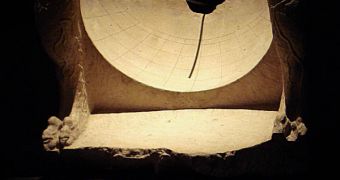British archaeologists working inside an abbey in Inchcolm Island have recently discovered a splintered sundial, which they believe may have originally been carved into one of the church's walls. The special kind of time-keeping instrument, known as a mass dial, was apparently the method of choice for keeping track of time in the Firth of Forth abbey, the BBC News reports.
The new find may help explain how the Augustine order kept track of time. They were widely renowned for their highly synchronized activities, which required that the members of the order did the exact same thing at the exact same time. Therefore, knowing where they were during the day, time-wise, was of the utmost importance. Archaeologists now believe that the mass dial was used to calculate what time it was as sharply as possible, and that the order's rituals revolved around this instrument.
The stone containing the carved dial was discovered by Hugh Morrison, a collection registrar at Historic Scotland, and Mary Markus, a medieval stone expert, while conducting preliminary preparatory work on a batch of 50 stones found at the abbey, which had not yet been analyzed. The instrument was found on two slabs of rock, which were most probably splintered by someone, or simply by the passing of time.
“While sorting through the stones I found a fragment with distinctive radial markings carved on it that reminded me of mass dials that I had seen on churches in Gloucestershire. In a separate location I turned over another stone and was really pleased to discover that it fitted together with the other half of the mass dial. Better still, it still has the corroded stub of the iron gnomon which would have once cast its shadow along the radial markings of the dial,” Morrison says.
“Medieval timekeeping was very different from our present day dependency on the accurate measurement of time for catching trains, getting to work or viewing TV programs. Changing seasons and weather meant that mass dials could not always be used but when the sun shone they provided a relative means of coordinating community activities,” he concludes.

 14 DAY TRIAL //
14 DAY TRIAL //